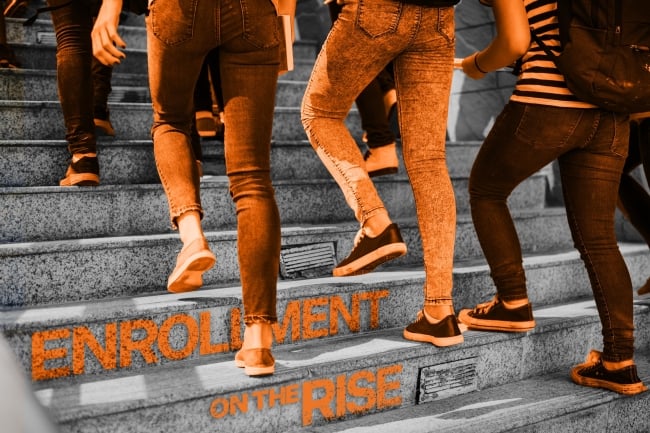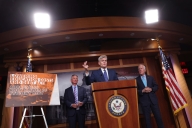You have /5 articles left.
Sign up for a free account or log in.

Undergraduate enrollment saw promising gains this spring, primarily in the community college and credential sector.
Photo illustration by Justin Morrison/Inside Higher Ed | Rawpixel
Undergraduate enrollment increased by 2.5 percent this spring, according to a report out today from the National Student Clearinghouse Research Center. It’s the second spring in a row that enrollments have increased and it builds on last fall’s 1.2 percent bump, continuing a slow but steady path to recovery from a devastating nosedive during the COVID-19 pandemic.
Most notably, spring enrollment in bachelor’s programs is up for the first time in four years at both public and private nonprofit institutions—and the 2.3 percent average growth rate is higher than the fall’s, a rarity. First-year enrollment is up by 3.9 percent overall, though it fell by 1.5 percent at private nonprofit four-year institutions. Graduate enrollment was up by 3 percent this spring, reversing last year’s losses.
Community colleges led the way, as they did in the fall. Despite accounting for only a quarter of all postsecondary enrollment, they were responsible for nearly half of the growth, with a 4.7 percent increase over last spring.
For the second year in a row, undergraduate enrollment rose at historically Black colleges and universities as well, and at an even higher rate: 4 percent, compared to 3.2 percent in 2023.
“It’s very encouraging that the trend started in the fall is continuing or even accelerating in the spring,” said National Student Clearinghouse (NSC) research director Doug Shapiro.
For the first time since the pandemic, enrollments rose across all four geographic regions—including the struggling Northeast, where first-time enrollment increased by 1.2 percent—and in 44 states. The states with the highest enrollment bumps were Georgia (6 percent) and Kentucky (5 percent), and only Washington and West Virginia had declines of 1 percent or more. In Massachusetts and Connecticut, where enrollments have been declining for years and small college closures are concentrated, enrollment rose by 3.2 and 2.8 percent, respectively.
Still, overall undergraduate enrollment remains behind pre-pandemic levels: by 3.5 percent at community colleges, which bore the brunt of the pandemic-era decline, and by about 1 percent each at public and private nonprofit four-year institutions. And a double-digit decline in the Free Application for Federal Student Aid (FASFA) completion rates after this year’s bungled rollout of the new form could stymie continued growth in the fall.
“The FAFSA rollout is very likely to have an impact on the fall numbers,” Shapiro said. “I’m still optimistic that students who really planned to go to college in the fall will get through this … but for a lot of students who were on the fence about college to begin with, my guess is many of them have made other plans.”
Undergraduate enrollment rose across most major fields of study at four-year institutions, but computer and information sciences outpaced all others significantly, with nearly 10 percent increases. Enrollment in education programs—in which declines have precipitated a nationwide teacher shortage in recent years—stabilized, declining only 0.1 percent.
Shapiro said that while the spring enrollment numbers are a positive sign for pandemic recovery, he’s not optimistic that growth rates will return to their peak a decade ago.
“That was an all-time high-water mark for higher ed, and I don’t know that anyone expects we’ll get back to that level anytime soon,” he said. “There are many students who were knocked off track during the pandemic, who still haven’t gotten back on—and may never get back on.”
A Short-Term Degree Boom
Associate degrees had the biggest enrollment boost, with 4.4 percent growth, followed by certificate programs at 3.6 percent. First-time freshmen enrollment at two-year institutions rose by 6.2 percent. High school dual-degree enrollment continued its meteoric post-pandemic rise this spring, with another 10 percent increase—the same as the fall—accounting for 28 percent of undergraduate enrollment increases, and largely driving the community college boost.
Nontraditional student enrollment also rose this spring: the number of adult students (21 and older) attending community colleges increased for the first time since 2020, by 3.8 percent.
“Older learners had some of the biggest declines during the pandemic, so the fact that we’re seeing some of them stabilize is great news,” Shapiro said. “Of course, their numbers are much smaller to begin with, so that has less of an impact on institutions.”
But the promising upward trends mask a less sunny reality. Despite driving undergraduate enrollment growth for the past year, community college enrollment is still 12.4 percent below spring 2020 levels. Meanwhile, public and private four-year colleges have nearly recovered to their spring 2020 levels; they are 0.7 and 1 percent below pre-pandemic enrollment, respectively.
Shapiro said that growth at community colleges has been particularly strong at vocationally focused schools and short-term credential programs, and less so at institutions that market themselves as pathways for transferring to a bachelors’ program.
John Fink, senior research associate and program lead at the Community College Research Center at Columbia Teachers’ College, said the trends aren’t surprising, but do reflect what he says is a public image problem with transfers, whose numbers have fallen precipitously in recent years but began to recover in the fall.
“The trends here really fit into a broader narrative around higher education’s value,” he said. “Students are seeing more value in shorter-term programs because there’s a perception that they’re closely connected to getting a job, and there’s less of a connection with a four- or six-year transfer pathway to a higher degree … that’s not great news, because there’s really so much more value in a four-year degree in terms of lifetime earnings and socioeconomic mobility, and transfers are the way so many low-income, underserved students get there."





